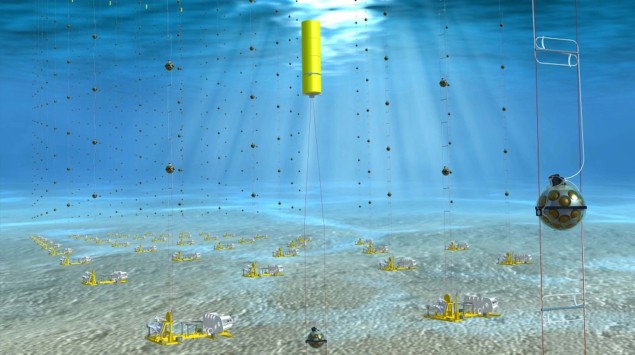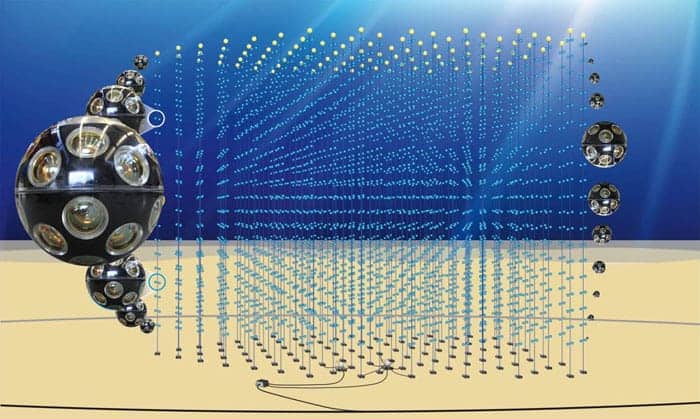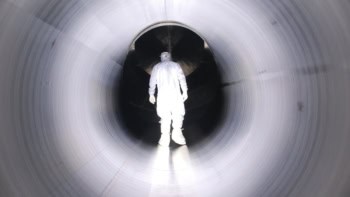
An international team of researchers has proposed an ambitious new experiment that would involve firing neutrinos from a particle accelerator in Russia to a detector 2500 km away in the Mediterranean Sea. The researchers claim that the facility would provide unparalleled insights into the properties of neutrinos and elucidate the mystery of why matter dominates over antimatter in the universe.
Neutrinos are fundamental particles that are created in huge numbers by cosmic sources but can also be produced by nuclear reactors and particle accelerators. As they interact only weakly with matter they are difficult to detect. There are currently three known types of neutrino that can oscillate between their different “flavours” as they travel. It was long believed that neutrinos have no mass, but we now know that they have one of three tiny, discrete masses. Yet scientists have not yet been able to determine the relative ordering of the three neutrino masses as well as discover the extent to which neutrinos violate charge-parity symmetry — a finding that could help to understand why the universe is dominated by matter rather than antimatter.
The experiment proposal has substantial support within the particle physics community in Europe as well as in Russia
Dmitry Zaborov
There are already several “long-baseline” accelerator neutrino experiments that are in operation or being developed, which are attempting to shed further light on the nature of neutrinos. The T2K experiment in Japan sends neutrinos from the Japan Proton Accelerator Research Complex in Tokai with energies around 600 MeV to the Super-Kamiokande detector some 295 km away. The US-based NOvA experiment, meanwhile, operates at 2 GeV over the 810 km distance between Fermilab in Chicago and a detector based in Minnesota. The planned Deep Underground Neutrino Experiment project, which is currently under construction, will produce a 3 GeV beam of neutrinos at Fermilab that are then sent 1300 km to an underground detector in South Dakota.
Maximum oscillation
Researchers in Europe have now proposed their own long-baseline facility. A collaboration of 90 researchers from nearly 30 research institutes have published a letter of interest to build the Protvino-ORCA (P2O) experiment. In the letter, they explain how they would upgrade a 70 GeV synchrotron particle accelerator at Protvino — 100 km south of Moscow — to generate a neutrino beam. According to the plans, this would then be sent to the Oscillation Research with Cosmics in the Abyss (ORCA) detector, which is currently being built off the coast of Toulon, France by the KM3NeT collaboration.
Neutrinos achieve maximum oscillation at different distances depending on their energy levels. P2O — with its 2595 km baseline — would allow it to achieve maximum oscillation at neutrino energies of around 4-5 GeV. Astroparticle physicist Paschal Coyle, who belongs to the KM3NeT collaboration, says that these parameters make P2O ideal for disentangling the effects of mass ordering and charge-parity violation. “In other long baseline experiments there are ambiguities that make it harder to decouple the two contributions,” he adds. KM3NeT neutrino sea-scope takes shape
The realisation of the P2O experiment will, however, not come soon. It would require the funding and construction of a new neutrino beamline at the accelerator in Protvino, aligned towards the ORCA site, as well as increases in the accelerator’s beam power from 15 kW to at least 90 kW. It may also require an upgrade to the ORCA detector, which has been designed to detect atmospheric neutrinos and is still under construction.
Dmitry Zaborov from the Kurchatov Institute in Moscow, who is one of the authors of the letter, says that P2O has been proposed for inclusion in the upcoming update to the European strategy for particle physics and also has the support of the KM3NeT/ORCA community. “The experiment proposal has substantial support within the particle physics community in Europe as well as in Russia,” he adds. The outcome of the strategy update will be concluded in May 2020.



